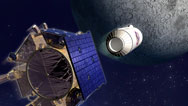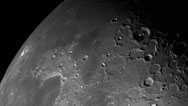Going Lunar for Less
- By Melissa Salpietra
- Posted 04.01.09
- NOVA scienceNOW
How do you put together an entire lunar mission on a tight time, weight, and funding budget? One way is to use spare parts and off-the-shelf supplies, and to incorporate space junk as a valuable scientific tool. In this video extra, see how the LCROSS team plans to do just this on its mission to search for water on the moon.
Transcript
Going Lunar for Less
Posted: April 1, 2009
NARRATOR: In 2005 the call went out from NASA. They had extra space on an orbiter heading to the moon and were looking for proposals for what to do with it. The competition was on and Ames Research Center was determined to impress the judges with their LCROSS mission--designed to search for water on the moon. But it wouldn't be easy to get a coveted hitchhiking spot on the lunar orbiter.
DAN ANDREWS (Project Manager, LCROSS): When the call went out for this competition, there were some constraints given. One was the mass constraint, thousand kilograms, but there was also a cost constraint. You could not propose a mission that came in higher than $80 million which is pretty inexpensive for lunar missions of course. And it has to be very fast turnaround.
NARRATOR: An entire lunar mission in 26 months from start to finish, with a strict weight limit and a tight budget. How do you do it?
DAN ANDREWS: The whole key with LCROSS is to use what exists. You take things that are available, you glue them together, you attach them in as simple a way as you can. You're not doing a bunch of custom designs and development. You're leveraging everywhere you can. And that's a really smart way to get the most out of the money that you're given.
NARRATOR: LCROSS pinched pennies by using off the shelf supplies and spare parts from other NASA missions. But what made LCROSS really standout was its unconventional use of a part normally used to attached objects to a rocket.
DAN ANDREWS: We joked that it's a sewer pipe, right? It's a big, over-designed piece of pipe and LCROSS is the first to come along and say well, wait a minute. Could I maybe actually create a whole spacecraft out of that, and actually use those ports for different functionalities of a spacecraft?
NARRATOR: Andrews and his team even designed LCROSS to make use of what would otherwise become space junk. It will hurtle its empty launch rocket at the moon in order to kick up lunar dust and analyze it for water.
DAN ANDREWS: We are the first lunar recyclers to actually make use of space junk, for a scientific purpose.
NARRATOR: With its ingenious and relatively low cost approach, LCROSS is paving the way for smaller scale missions that compliment the big-budget projects for which NASA is famous.
DAN ANDREWS: If the NASA portfolio were nothing but infrequent, very large missions that were staged many years apart, and cost a lot of money, and a lot of development time, and there was nothing else, then we would be slow and expensive. LCROSS, I think, is bringing up some of this small, lower end opportunity. And that's where the small guys are able to come in, look at that technology, take it, apply it, change the culture a little bit, manage the risk, and off you go.
Credits
- Video short produced and narrated by
- Melissa Salpietra
- Original footage produced for NOVA scienceNOW by
- Josh Rosen.
Related Links
-

Moon Smasher
A NASA satellite called LCROSS heads to the moon in hope of finding buried water.
-

Moon Smasher: Expert Q&A
NASA's Dan Andrews answers questions about LCROSS and how it might pave the way for future space exploration.
-

Back to the Moon
Hear David Morrison of NASA's Lunar Science Institute explain why we need to return to the moon.



